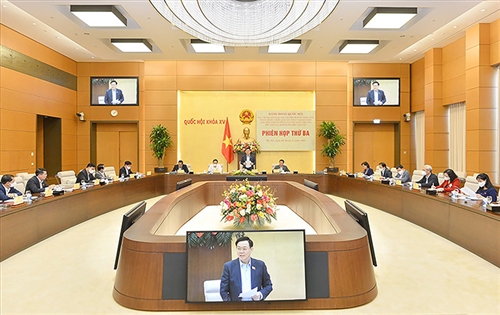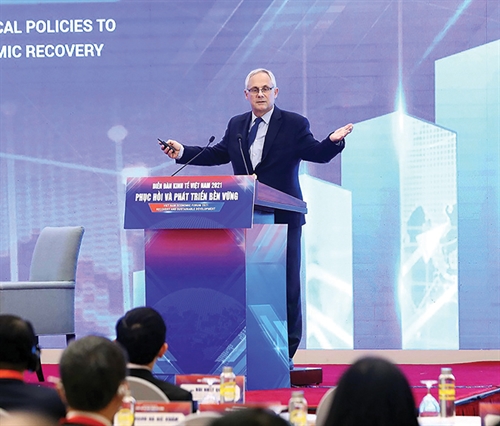“Improving institutional quality, developing human resources and digital finance platform, and unblocking and promoting financial potential would be considered three breakthroughs in implementation of the recently issued Financial Strategy.” This statement was made by Dr. Nguyen Nhu Quynh, Director of the National Institute for Finance under the Ministry of Finance, at an interview with the Thoi bao Tai chinh Viet Nam (Vietnam Financial Times).
The Financial Strategy up to 2030 was issued by the Prime Minister in March. Could you brief about the most-highlighted targets and tasks set out in the Strategy?
The Financial Strategy up to 2030 was approved by the Prime Minister under Decision 368/QD-TTg with the overall objectives of “building the national finance toward sustainability, modernity and integration, contributing to promoting growth and enhancing the resilience of the economy while ensuring macroeconomic stability and national financial security; reasonably mobilizing financial resources, improving fiscal space, facilitating the mobilization, allocation and use of financial resources in an effective manner, harmoniously resolving socio-economic and environmental issues, and ensuring national defense and social security in association with the objectives and tasks of the 2021-30 Socio-Economic Development Strategy”.
In light of this, the Strategy points out seven groups of specific targets and tasks of which the most salient ones are those involving state budget revenues and expenditures, budget deficit and public debts with the prime goal of ensuring financial and budgetary resources for fulfillment of socio-economic development, security and defense objectives and tasks.
To this end, the average state budget revenue-to-GDP ratio must not be lower than 16 percent in 2021-25 and kept at 16-17 percent during 2026-30 with revenues from taxes and charges equaling about 13-14 percent and 14-15 percent of GDP, respectively. The proportion of domestic revenues to total budget revenues will reach 85-86 percent by 2025 and 86-87 percent by 2030.
The Strategy also aims at other objectives, including effectively managing state budget expenditures, further restructuring state budget spending toward sustainability; prioritizing and increasing development investment expenditures, ensuring resources for debt repayment, increasing state budget resources for national reserves, raising spending on human development, and ensuring social security. Current expenditures and development investment spending are set to account for 62-63 percent and 28 percent of the total state budget expenditures during 2021-25. It is expected that these rates would be reduced to around 60 percent and increased to 29 percent in reality.
During 2021-30, priority will be given to allocating state budget funds to raise national reserve potentials in conformity with the state budget’s capacity so as to be ready to make quick and effective responses in unexpected urgent circumstances.
Additionally, it is necessary to gradually reduce state budget deficits and strictly manage public debts, thus ensuring the safety of public debts and security of national finance. Hence, the State needs to raise revenues, save spendings and reduce state budget deficits to achieve the set deficit targets of around 3.7 percent of GDP during 2021-25 and 3 percent of GDP by 2030. Great fluctuations or risks, if any, will be reported by the Ministry of Finance to the Government for submission to the National Assembly for consideration and decision.
For public debt targets, in the 2021-25 period, the annual public debt ceiling will be kept at 60 percent of GDP; government debt, 50 percent of GDP, and national external debt, 50 percent of GDP. By 2030, these figures will be 60 percent, 50 percent, and 45 percent, respectively.
| The Financial Strategy through 2030 will be implemented in two phases of 2021-25 and 2026-30, in correspondence to the 2021-25 and 2026-30 Financial Plans. Together with the Strategy, the finance sector will also implement eight sectoral strategies, namely the Strategy on tax system reform through 2030; Strategy on customs development through 2030; Strategy on development of the state treasury system through 2030; Strategy on public debts through 2030; Strategy on development of Vietnam’s insurance market through 2030; Strategy on development of the stock market through 2030; Strategy on development of national reserves through 2030; and Strategy on accounting-auditing through 2030.- |
The Strategy sets forth the task of further improving laws and policies on finance-state budget, especially tax policies. Hence what should we do in the coming period in order to improve the fiscal space while still facilitating business activities and socio-economic development?
Improvement of policies and laws on finance-state budget is the key task of the finance sector in the coming time. In particular, the finance sector attaches special importance completing tax policies to ensure reasonable mobilization of resources for the state budget, contributing to creating a competitive environment in line with the process of economic integration and development. The tax policy system will be reviewed for improvement in the direction of covering all sources of revenues and expanding bases of collection, especially new sources of revenues, for it to become suitable to reality and conformable with integration commitments and good international practices.
At the same time, the finance sector will also study and set reasonable tax rates, ensuring the fairness and neutrality of the tax policy system; review and adjust tax incentive policies, removing those that no longer meet development requirements; and minimize the incorporation of social policies in taxes and revenues.
These moves will contribute to improving fiscal space and facilitating the implementation of tax solutions to support businesses and people to overcome difficulties caused by the Covid-19 pandemic during the first years of the Strategy, thus helping the economy recover and develop and ensure finance-state budget balance.
What are strategic financial breakthroughs for the next 10-year period and what will the finance sector do to realize such objectives?
The Strategy mentions three financial breakthroughs: improving institutional quality, developing human resources and digital financial platform, and unblocking and promoting financial potential.
Firstly, it is required to boost the improvement and raising of quality of financial institutions, ensuring completeness, synchronism and conformity with integration requirements. Besides, the mechanism on state budget management decentralization and fund allocation will be renewed, emphasizing the leading role of the central budget while promoting proactiveness of local budgets. The state budget will be restructured, together with development of a modern, transparent and sustainable financial market.
Secondly, financial mechanisms and policies will be revised to serve development of human resources, science and technology and innovation activities. Digital finance platforms will be developed on the basis of information technology application combined with digital transformation.
Thirdly, financial potential will be unblocked and promoted so as to develop the socio-economic infrastructure system with priorities given to resources for performance of economic recovery and development tasks.
In order to realize the above-said three breakthroughs, the Strategy sets forth 11 groups of solutions, including improving policies on mobilization of national financial resources and raising effect and effectiveness of state budget collection management; raising the effectiveness in allocation, management and use of financial resources in association with promoting economic restructuring and sustainable development; and strictly and effectively managing state budget deficits and public debts.-









